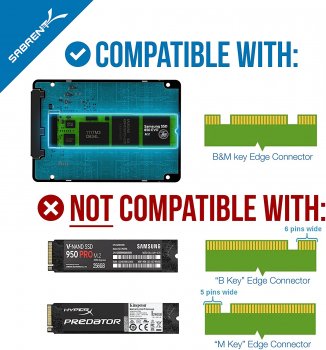INTRO
Hello, I do hope you as the reader are well!
I have been given a Late 2012 iMac 2.7ghz 21.5" as a gift, and it is painfully slow. The HDD corrupted and it is running off an external HDD connected via USB. So I am looking to add a few upgrades. I am focussing on the RAM and SSD as the CPU and GPU are fine and I don't think I need to upgrade them. I'll be using this computer for Video Editing and Graphic Design. This is my first post here and I'm new to computer upgrades, so shout if anything is unclear.
SSD UPGRADE
I wanted to see if any other Mac owners have been able to use an NVMe SSD on a iMac that is from an older generation. The issue is, with the current SATA input I can plug in a normal SATA SSD, which is fine, clocking R/W (Read/Write) speeds of 500 mb/s, but the NVMe SSD's can clock R/W over 2000 mb/s! So you can see why I would love to opt for a NVMe over a traditional SATA SSD. Please let me know if you know of any adaptors/convertors that can connect the SATA port to a M-Key NVMe Driver. See the photo attached, this shows that most of the adapters are compatible with the m.2 SSD's using a M/B -key, however, they do not support the NVME M-Key or B-Key drivers. And ones that do tend to only connect to PCIE instead of SATA.
RAM Upgrade
I have been monitoring my RAM usage and it is using around 70-80% of the RAM most of the time, which is concerning. I only have 2 ports with 4gb 1600hz (8gb total) DDR3 RAM inputted available. Do you think the upgrade to 2 x 8gb DDR3 RAM (12gb in total) is worth the money? I checked and the Mac can go up to 16gb of RAM so it is fine for the upgrade.
Thank you for your help!
Hello, I do hope you as the reader are well!
I have been given a Late 2012 iMac 2.7ghz 21.5" as a gift, and it is painfully slow. The HDD corrupted and it is running off an external HDD connected via USB. So I am looking to add a few upgrades. I am focussing on the RAM and SSD as the CPU and GPU are fine and I don't think I need to upgrade them. I'll be using this computer for Video Editing and Graphic Design. This is my first post here and I'm new to computer upgrades, so shout if anything is unclear.
SSD UPGRADE
I wanted to see if any other Mac owners have been able to use an NVMe SSD on a iMac that is from an older generation. The issue is, with the current SATA input I can plug in a normal SATA SSD, which is fine, clocking R/W (Read/Write) speeds of 500 mb/s, but the NVMe SSD's can clock R/W over 2000 mb/s! So you can see why I would love to opt for a NVMe over a traditional SATA SSD. Please let me know if you know of any adaptors/convertors that can connect the SATA port to a M-Key NVMe Driver. See the photo attached, this shows that most of the adapters are compatible with the m.2 SSD's using a M/B -key, however, they do not support the NVME M-Key or B-Key drivers. And ones that do tend to only connect to PCIE instead of SATA.
RAM Upgrade
I have been monitoring my RAM usage and it is using around 70-80% of the RAM most of the time, which is concerning. I only have 2 ports with 4gb 1600hz (8gb total) DDR3 RAM inputted available. Do you think the upgrade to 2 x 8gb DDR3 RAM (12gb in total) is worth the money? I checked and the Mac can go up to 16gb of RAM so it is fine for the upgrade.
Thank you for your help!


